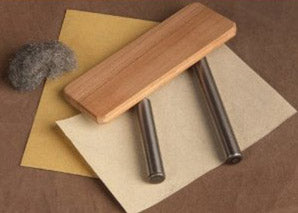on orders over $45*
on orders over $45*
Fret Buzz is a fairly common problem with both electric and acoustic guitars. In a nutshell, fret buzz occurs when your guitar string vibrates against the frets of your guitar neck, it's a fairly common but frustrating problem. In some cases it can be solved by changing your old strings that have built up too much of a film, however, it can also be related to the straightness of your guitar neck which is a little more involved.
Also read: How to Adjust your Guitar Intonation
In some cases, you may experience some minor buzzing when playing or in more extreme cases your string will actually completely deaden when you fret a higher note. There are several potential solutions that can help you reduce fret buzz. Quite simply, you either need to fix a problem with the instrument itself or in some cases fix your technique.
The first step is to figure out if the guitar itself is the problem. The first port of call should be your strings.
Have they been on the guitar for an extended period?
Do they feel grimy?
Strings can build up enough of a film over time to cause fret buzz problems. Chances are if this is a new guitar kit this won't be the problem.
Recommended: Everything you ever wanted to know about Guitar Strings
Next, we need to inspect the frets, all frets need to be level. There are tools available that will help you do this, it's really not that difficult once you have an understanding of the process. Erosion to even one fret might suggest that you need to do some leveling and re-crowning in order to improve performance and reduce fret buzz.

The Buzz-Off Fret Leveling Kit: Used to find and
level high frets in order to remove fret buzz.
If you only intend on building one guitar this might be a job for your local guitar repair shop. If you do however intend on building many guitars or just want to learn how to do it yourself (Let's face it you are probably building your guitar for this very reason) there are several tools available to assist you to also crown and polish your frets so they look and work like new.
Before you move forward and check any other potential problems with your guitar kit's composition, ensuring that your frets themselves are in good working condition is essential. It’s the most likely place to start and could save a lot of work in the long run.
Recommended: How to Fix Uneven Frets
Once your frets are in proper working order or you have identified that this isn't the problem and you’re still getting some buzz you should move on to your guitar neck. The strings should not come into contact with anything under them, which is where neck relief comes in. Neck relief prevents the strings from hitting the frets but keeps them as close as possible to the guitar while it vibrates. Tightening or loosening the truss rod nuts adjusts the relief.
Also read: A Step by Step Guide to Truss Rod Adjustment
Most of the time the truss rod will need loosening as the neck will either be too straight or has a backward bow to it.
Guitar necks should never be perfectly straight.
In order to achieve an optimal balance of neck relief and string height, you’ll need to spend some time experimenting. Strings vary in stiffness, so some need more distance while others need less. String experimentation can be carried out fairly easily.
You also need to consider nut height, which you can determine by using an automotive feeler gauge. The key is to press down the string after the third fret. The distance between the string and the first fret should be about 10 one-thousandths of an inch. If it’s significantly more than that, you’ll need to replace the nut or hire a pro to cut your nut slots more deeply.

If your guitar is in good working condition and you still have to fret buzz, it’s unfortunately, more than likely your technique that requires some tweaking. With your left hand, you should be aiming to push the string 45 degrees into the gap between the fretboard and the fret. It’s easier said than done, but it will reduce fret buzz.
Your right-hand technique is a bit harder to adjust. Basically, strumming too hard or improperly does nothing to help a fret buzz problem. Learning proper techniques will not only improve your ability to play guitar, but it should help eliminate any remaining fret buzz problems as well.